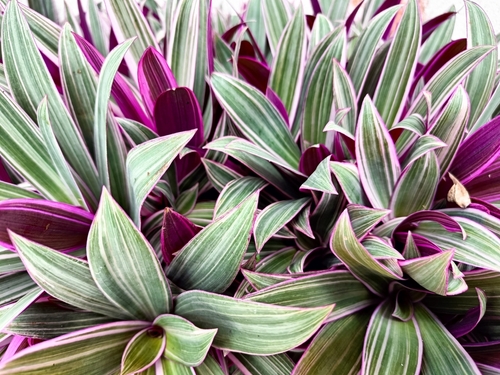Tradescantia is a popular houseplant known for its beautiful and colorful foliage. However, if you notice your Tradescantia turning brown, it can be a cause for concern. There are several reasons why your Tradescantia may be turning brown, and it’s important to identify the cause to prevent further damage to your plant.
One of the most common reasons for browning leaves in Tradescantia is due to light requirements. Tradescantia prefers bright, indirect light, and too much direct sunlight can cause the leaves to burn and turn brown.
Another reason for browning leaves is due to watering practices. Overwatering or underwatering can cause stress to the plant and lead to browning leaves. Understanding the needs of your Tradescantia is crucial to maintain its health and beauty.
Key Takeaways
- Tradescantia turning brown can be caused by a variety of factors including light requirements, watering practices, soil and drainage, temperature and humidity, and potential pests and diseases.
- Identifying the cause of browning leaves is essential to prevent further damage to your plant.
- Proper care and maintenance of your Tradescantia, including providing the right amount of light, water, and nutrients, can help prevent browning leaves and keep your plant healthy and vibrant.
You shouldn’t miss out on these other top posts:
- Why Is My Tradescantia Nanouk Turning Brown?
- Sago Palms Turning Brown
- Sago Palm Leaves Turning Brown
Understanding Tradescantia
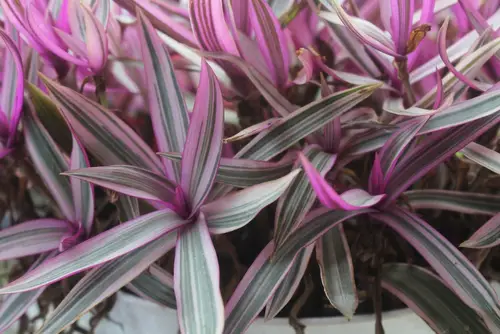
Tradescantia is a genus of plants that includes several species commonly known as Wandering Jew plants. These plants are native to Central and South America, but they are now grown all over the world as houseplants due to their attractive foliage and ease of care.
Some of the most popular species of Tradescantia include Tradescantia zebrina, also known as the Purple Heart, and Tradescantia Nanouk, also known as T. Nanouk.
Tradescantia plants are known for their striking foliage, which can range from green to purple to pink, depending on the species and variety. They are also known for their trailing growth habit, which makes them ideal for hanging baskets or as ground cover in outdoor gardens.
While Tradescantia plants are generally easy to care for, they can be prone to a few common problems. One of the most common issues is browning of the leaves, which can be caused by a variety of factors, including overwatering, underwatering, low humidity, or too much direct sunlight.
It’s important to note that different species of Tradescantia may have slightly different care requirements, so it’s important to research the specific needs of your plant to ensure that it stays healthy and happy.
Identifying Browning Leaves
Tradescantia plants are known for their vibrant foliage, and browning leaves can be a sign that something is wrong. Before taking any corrective action, it is important to identify the cause of the browning.
Browning leaves can be caused by a variety of factors, including lack of humidity, overwatering, underwatering, too much direct sunlight, and nutrient deficiencies. It is essential to closely examine the leaves to determine the cause of the browning.
If the browning is occurring at the edges of the leaves and gradually spreading inward, it may be due to low humidity. Tradescantia plants prefer high humidity levels, and if the air is too dry, the leaves may begin to dry out and turn brown.
Placing a humidifier near the plant or misting the leaves regularly can help increase humidity levels and prevent further browning.
Overwatering or underwatering can also cause browning leaves. If the soil is consistently wet or the plant is not receiving enough water, the leaves may begin to turn brown. It is important to ensure that the soil is well-draining and that the plant is receiving the appropriate amount of water for its needs.
If the browning is occurring in patches or spots on the leaves, it may be a sign of a nutrient deficiency. Tradescantia plants require regular fertilization to maintain healthy growth and vibrant foliage. Adding a balanced fertilizer to the soil can help address nutrient deficiencies and prevent further browning.
In some cases, browning leaves may be a sign of a more serious issue, such as a fungal or bacterial infection. If the browning is accompanied by other symptoms, such as wilting or yellowing leaves, it is important to consult a plant expert or horticulturist for guidance.
Light Requirements
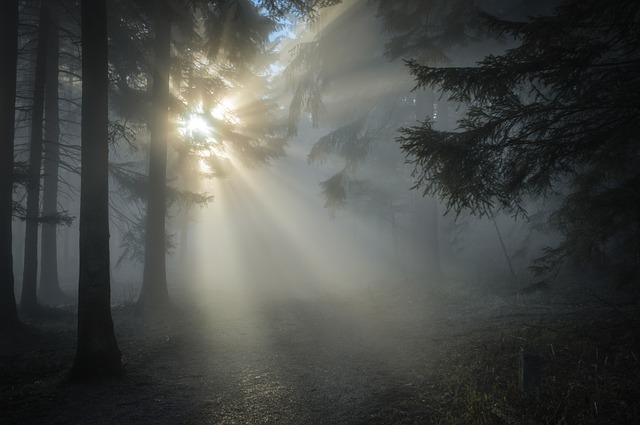
Tradescantias require bright, indirect light to thrive. They can tolerate some direct sun, but too much can scorch their leaves. If the plant is placed in a north-facing window or an area with insufficient light, it may become leggy and lose its vibrant colors.
If the plant is placed in a sunny window, it is recommended to filter the light with a sheer curtain or move the plant a few feet away from the window. If the plant is placed under a grow light, it should be positioned about 12 inches away from the light source.
It is important to note that different species of tradescantia may have slightly different light requirements. For example, Tradescantia zebrina prefers bright, indirect light, while Tradescantia fluminensis can tolerate lower light levels.
Watering Practices
Tradescantias are sensitive to watering, and improper watering can cause the leaves to turn brown. Both over and under watering can be culprits in this situation. It is important to find the right balance to keep the plant healthy and thriving.
1. How Often to Water
The frequency of watering depends on various factors such as the size of the pot, the type of soil, and the humidity levels in the environment. As a general rule of thumb, it is best to water the plant when the top inch of soil feels dry to the touch. Overwatering can lead to root rot, which can cause the plant to die.
2. How to Water
When watering, it is important to water thoroughly and evenly. This means that the water should reach all parts of the soil, and not just the surface. If the plant is in a pot with drainage holes, allow the water to drain out completely before placing it back in its spot.
If the plant is in a cache pot without drainage holes, it is important to be careful not to overwater, as the excess water can accumulate and cause root rot.
3. Signs of Overwatering
Overwatering can cause the plant to wilt, and the leaves to turn brown and mushy. The soil may also have a foul smell, and the roots may appear brown and mushy. If the plant is overwatered, it is important to stop watering immediately and allow the soil to dry out completely before watering again.
4. Signs of Underwatering
Underwatering can cause the leaves to turn brown and dry. The soil may also appear dry and crumbly. If the plant is underwatered, it is important to water it thoroughly and evenly, and to ensure that the soil is moist but not waterlogged.
By following these watering practices, one can help prevent their Tradescantia from turning brown due to improper watering.
Soil and Drainage
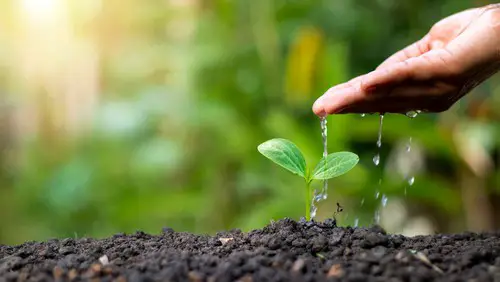
One of the main reasons why Tradescantia leaves turn brown is due to poor soil and drainage. Tradescantias prefer well-draining soil that is moist but not waterlogged. If the soil is too dense or compact, it can retain too much moisture, leading to root rot and brown leaves.
When planting Tradescantias, it is important to choose a pot with drainage holes and a saucer to catch excess water. This allows the water to drain out of the pot, preventing the soil from becoming waterlogged. It is also recommended to use a well-draining soil mix that contains perlite or sand to improve drainage.
If the brown leaves are due to poor soil and drainage, it is important to repot the plant in fresh soil. Gently remove the plant from the pot, loosen the roots, and remove any damaged or rotted roots. Place the plant in a new pot with fresh soil, making sure to cover the roots with soil and water thoroughly.
In addition to ensuring proper soil and drainage, it is important to avoid overwatering Tradescantias. Allow the soil to dry out slightly between waterings, and only water when the top inch of soil feels dry to the touch. This can help prevent the soil from becoming waterlogged and reduce the risk of root rot and brown leaves.
Temperature and Humidity
Tradescantias are tropical plants that thrive in warm and humid environments. Changes in temperature and humidity levels can cause the leaves to turn brown and curl up.
To maintain the ideal temperature and humidity conditions for your Tradescantia, it’s best to keep it in a room that is between 60-85°F (16-29°C) and has a relative humidity level of 40-60%.
If the air in your home is too dry, you can increase the humidity by using a humidifier, placing a pebble tray filled with water near the plant, or misting the leaves with water.
Misting is a popular method to increase humidity levels, but it’s important to do it correctly. Misting the leaves too often or with too much water can cause fungal growth and damage the plant. It’s best to mist the leaves lightly once or twice a week, especially during the dry winter months.
Another way to increase humidity levels is by using a pebble tray. Fill a tray with pebbles and add water until it reaches just below the top of the pebbles. Place the plant on top of the pebbles, making sure the water level does not touch the bottom of the pot. As the water evaporates, it will create a humid microclimate around the plant.
Fertilizing and Pruning

Tradescantias are fast-growing plants that require regular pruning to maintain their shape and size. Pruning also helps to stimulate new growth and prevent leggy stems. It’s best to prune in the spring or early summer when the plant is actively growing.
When it comes to fertilizing, tradescantias are not heavy feeders and can do well with a general-purpose indoor plant fertilizer. Liquid fertilizers can be used every two weeks during the growing season, but it’s important not to over-fertilize as this can lead to burnt roots and brown leaves.
When applying fertilizer, it’s best to follow the instructions on the package and dilute the fertilizer to half-strength. This will prevent fertilizer burn and ensure that the plant receives the nutrients it needs without being overwhelmed.
In terms of pruning, it’s important to use clean, sharp scissors or pruning shears to avoid damaging the plant. Cut back any leggy stems or dead leaves to encourage new growth and maintain the plant’s shape.
Repotting Tradescantia
Repotting is an essential part of caring for your Tradescantia plant. It helps the plant to grow and thrive by providing it with fresh soil and more space to spread its roots. Tradescantia plants should be repotted every one to two years, depending on how fast they grow.
When repotting your Tradescantia, it is important to choose a larger pot than its current one. The new pot should be about 2 inches larger in diameter than the current pot. This will give the plant enough room to grow and spread its roots.
Before repotting, make sure to water the plant thoroughly. This will help the soil to stay together when you remove the plant from the pot. Gently remove the plant from its current pot, being careful not to damage the roots.
Once you have removed the plant from its pot, loosen the soil around the roots. If the roots are tightly packed, you can use a fork or your fingers to loosen them. This will help the plant to absorb water and nutrients more easily.
When repotting, it is important to use fresh soil. You can use a mixture of potting soil and perlite to provide good drainage. Make sure to mix the soil well before filling the new pot.
After filling the new pot with soil, place the plant in the center and fill in the gaps with soil. Make sure not to bury the stem too deep, as this can cause it to rot. Water the plant thoroughly, and let it drain before placing it in a bright, indirect light.
To help the plant adjust to its new environment, it is recommended to dilute the fertilizer by half and apply it every two weeks for the first month. This will help the plant to grow strong and healthy.
By following these simple steps, you can help your Tradescantia plant to thrive and grow into a beautiful, healthy plant.
Potential Pests and Diseases

Tradescantia plants are generally hardy and resistant to pests and diseases. However, they can still be susceptible to certain issues that can cause browning of the leaves. Here are some potential pests and diseases that may be causing your Tradescantia to turn brown:
1. Spider Mites
Spider mites are tiny pests that can infest your Tradescantia plant and cause the leaves to turn brown and wilt. These pests are difficult to see with the naked eye and can quickly spread to other plants in your home.
If you suspect that spider mites are causing your Tradescantia to turn brown, you should isolate the plant and treat it with a mild insecticidal soap.
2. Wilt
Wilt is a common problem that can cause Tradescantia leaves to turn brown and droop. This issue is typically caused by overwatering or underwatering the plant. To prevent wilt, make sure that your Tradescantia is planted in well-draining soil and water it only when the soil is dry to the touch.
3. Dust
Dust can accumulate on the leaves of your Tradescantia plant and cause them to turn brown. This is because dust can block the pores on the leaves, preventing them from getting the nutrients they need. To prevent dust buildup, make sure to wipe down the leaves of your plant with a damp cloth or sponge on a regular basis.
Safety Precautions for Pets
Tradescantia plants are known to be toxic to pets if ingested. It is important to take precautions to keep your pets safe if you have this plant in your home.
1. Toxicity
Tradescantia plants contain calcium oxalate crystals, which can cause irritation and swelling of the mouth, tongue, and throat if ingested. Symptoms of toxicity in pets include drooling, vomiting, difficulty swallowing, and decreased appetite.
2. Preventing Ingestion

To prevent pets from ingesting the plant, it is recommended to keep it out of their reach. Place the plant on a high shelf or in a room that your pet does not have access to. If you have a curious pet that likes to explore, it may be best to avoid having this plant in your home altogether.
3. What to Do if Ingested
If you suspect that your pet has ingested a Tradescantia plant, it is important to seek veterinary care immediately. Do not induce vomiting unless instructed to do so by a veterinarian. Treatment may include administering activated charcoal to absorb the toxins or providing supportive care to manage symptoms.
Propagation of Tradescantia
Tradescantia is a popular houseplant that is easy to propagate. Propagation is the process of creating new plants from existing ones. It can be done by taking cuttings from the parent plant and rooting them in water or soil. Propagation is a great way to create more plants, make your plant bushier, or replace a dying plant.
To propagate Tradescantia, take a cutting that is a few inches long with at least two leaves. Cut the stem just below a node, which is where the leaves attach to the stem. Remove the bottom leaves from the cutting, leaving about an inch of bare stem. This will help the cutting focus on growing roots instead of supporting leaves.
Next, place the cutting in a jar or vase of water. Make sure the bottom of the stem is submerged in the water, but the leaves are not touching the water. Change the water every few days to prevent bacteria growth. After a few weeks, the cutting should start to grow roots.
Once the roots are a few inches long, the cutting can be transplanted into soil. Use a pot with well-draining soil and make a hole in the soil with your finger. Gently place the cutting in the hole and cover it with soil. Water the soil thoroughly and place the pot in a bright, indirect light.
Another way to propagate Tradescantia is by layering. This method involves bending a stem down to the soil and covering it with soil. After a few weeks, the stem should start to grow roots. Once the roots are a few inches long, the stem can be cut from the parent plant and transplanted into its own pot.
Propagation is a great way to create more plants and keep your Tradescantia healthy. With a little patience and care, you can have a bushy plant with long vines in no time.
Special Care for Different Varieties
Tradescantia plants come in different varieties, each with unique features and care requirements. Understanding the special care required for each variety can help prevent browning and keep them looking vibrant.
1. Variegated Tradescantia
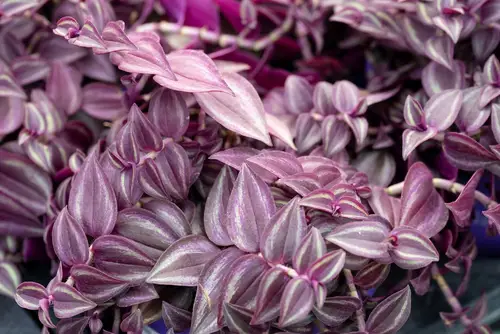
Variegated Tradescantia, also known as Wandering Jew, is a popular variety known for its colorful foliage. The leaves of this plant have stripes of purples, silvers, pinks, whites, or yellows. However, if the plant is not getting enough light, the colors may fade, and the leaves may turn brown.
To prevent browning and fading, place variegated Tradescantia in a bright spot where it can receive indirect sunlight. Avoid placing it in direct sunlight as this can cause the leaves to burn. Additionally, make sure to keep the soil moist, but not waterlogged.
2. Tradescantia Nanouk
Tradescantia Nanouk is a relatively new variety that has gained popularity due to its vibrant pink and purple coloration. This plant requires bright, indirect light and regular watering to keep it healthy. However, too much water can cause the leaves to turn brown and mushy.
To prevent browning, make sure to water your Tradescantia Nanouk only when the top inch of soil is dry. Additionally, avoid placing it in a location with low humidity levels as this can cause the leaves to dry out and turn brown.
3. Tradescantia Zebrina
Tradescantia Zebrina, also known as Inch Plant or Wandering Jew, is another popular variety known for its long vines and leggy growth. This plant requires bright, indirect light and regular watering to keep it healthy. However, if the plant is not getting enough light, the leaves may turn brown and drop off.
To prevent browning and leggy growth, make sure to give your Tradescantia Zebrina enough light. Additionally, avoid overwatering the plant as this can cause root rot and browning of the leaves. Finally, consider pinching back the stems to encourage bushier growth.
Tradescantia in Different Environments
Tradescantia is a versatile plant that can thrive in different environments. However, it is important to note that the ideal environment for this plant varies depending on the species. In general, Tradescantia prefers bright, indirect light and well-draining soil.
In the bathroom, Tradescantia can thrive due to the high humidity levels. However, if the plant is placed too close to the shower or bath, it may be exposed to direct water droplets that can cause sunburn or lead to fungal infections.
To prevent this, it is recommended to place the plant in an area that receives indirect light and away from direct water exposure.
In the kitchen, Tradescantia can benefit from the steam and humidity produced during cooking. However, it is important to keep the plant away from direct heat sources such as the stove or oven. The heat can cause the leaves to dry out and turn brown.
If the plant is placed near a radiator, it may experience dry air, which can cause the leaves to turn brown and crispy. To prevent this, it is recommended to place a humidifier near the plant or to mist the leaves regularly.
If the plant is exposed to direct sunlight, it may experience sunburn, which can cause the leaves to turn brown and dry out. To prevent this, it is recommended to place the plant in an area that receives bright, indirect light or to use a sheer curtain to filter the light.
Frequently Asked Questions
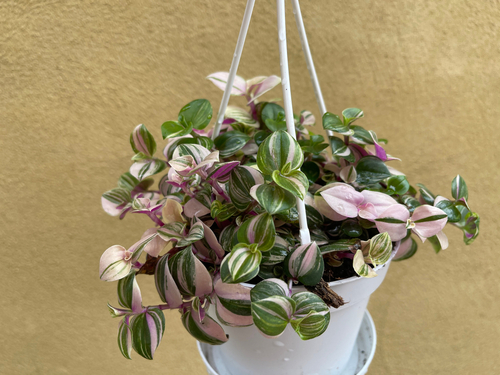
What causes brown spots on Tradescantia leaves?
Brown spots on Tradescantia leaves can be caused by various reasons, such as overwatering, underwatering, pests, or diseases. Overwatering can lead to root rot, which causes brown spots on the leaves.
Underwatering can cause the plant to become dehydrated, leading to brown spots on the leaves. Pests, such as spider mites or mealybugs, can also cause brown spots on the leaves. Diseases, such as leaf spot or bacterial blight, can also cause brown spots on the leaves.
Why are the leaves on my Wandering Jew plant turning brown at the base?
The leaves on a Wandering Jew plant can turn brown at the base due to overwatering, underwatering, or root rot. Overwatering can cause the roots to become waterlogged, leading to root rot and brown leaves.
Underwatering can cause the plant to become dehydrated, leading to brown leaves. Root rot can also cause brown leaves, as the roots become damaged and cannot absorb water properly.
How do I revive a dying Wandering Jew plant?
To revive a dying Wandering Jew plant, you should first check the soil moisture level. If the soil is dry, water the plant thoroughly. If the soil is wet, let it dry out before watering again.
You should also check for pests or diseases, and treat the plant accordingly. If the plant is severely damaged, you may need to prune it back to promote new growth.
What are the signs of overwatering Tradescantia?
The signs of overwatering Tradescantia include yellowing leaves, soggy soil, and a foul odor coming from the soil. Overwatering can cause the roots to become waterlogged, leading to root rot and damage to the plant.
How do I save a dying Tradescantia?
To save a dying Tradescantia, you should first identify the cause of the problem. Common causes of a dying Tradescantia include overwatering, underwatering, pests, or diseases.
Once you have identified the cause, you can take steps to address the problem. For example, if the plant is overwatered, you should reduce watering and allow the soil to dry out before watering again. If the plant has pests, you should treat it with an appropriate insecticide.
What causes Tradescantia Nanouk leaves to turn brown?
Tradescantia Nanouk leaves can turn brown due to overwatering, underwatering, pests, or diseases. Overwatering can cause the roots to become waterlogged, leading to root rot and brown leaves.
Underwatering can cause the plant to become dehydrated, leading to brown leaves. Pests, such as spider mites or mealybugs, can also cause brown leaves. Diseases, such as leaf spot or bacterial blight, can also cause brown leaves.

Hey, I’m Lisa and I’ve been an avid gardener for over 30 years. I love writing, talking and living in the garden! Feel free to connect with me on my socials below

